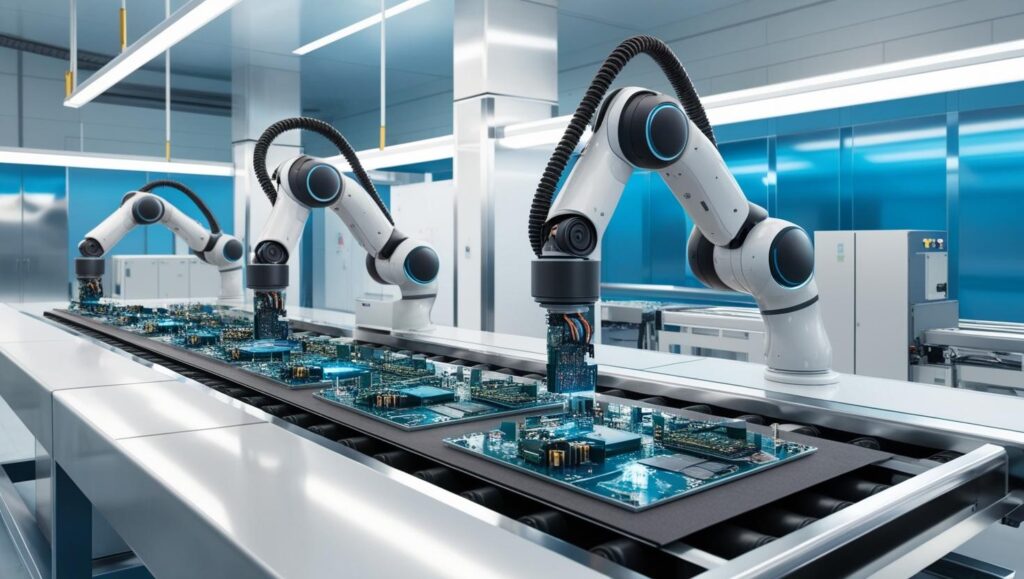Proposed tech tariffs have led to a lot of uncertainty for manufacturers. Check out our exclusive interviews with Locus Robotics Chief Executive Officer Rick Faulk and OnRobot Chief Commercial Officer James Taylor about how organizations can and must scale in the current environment.

The only thing that seems certain right now is uncertainty, and that uncertainty is impacting automation.
Tech tariffs are on the table and then off. The U.S. is embarking upon an all-out trade war with China. And manufacturers are left wondering how their automation efforts can be scaled when the only thing we know for sure is that we don’t know.
Control Engineering’s State of Industrial Automation report found that 60% of organizations adopting new automation technologies are doing so at a moderate rate with just 28% doing so conservatively due to budget constraints or system integration challenges.
Given the uncertainty about proposed tariffs on components like semiconductors, steel, aluminum and more, what do these organizations need to know about scaling those automation efforts? How can manufacturers execute on their automation strategies when there’s so much uncertainty about which components will be tariffed and by how much?
The list of imported component parts and tech on target for tariffs is extensive. And the United States International Trade Commission keeps amending and updating these items as news changes.

Tackling tariffs head-on for automation
When it comes to distributors and integrators, delivering ongoing projects is a challenge, but it’s one that some automation innovators are tackling head-on.
James Taylor, chief commercial officer with OnRobot, said in an interview that his organization tried to get ahead of the tariffs by offering a discount to U.S. customers.
“The tariffs were a surprise to us,” Taylor said. “What we did immediately is offset through a discount to our customers in the U.S.”
For the first round of reciprocal tariffs were announced, Taylor said OnRobot offered a higher discount to offset those tariffs, but when the government decided to pause the reciprocal tariffs for a baseline of 10%, that discount was lowered.
“It’s keeping us on our toes, so to speak, but we’re at least trying to do our part in helping our partners plan. We know our partners, our distributors, our integrators, already have projects out, already have projects quoted, they’re in delivering. When a tariff policy changes when things are en route, it makes things a little bit difficult.”
Taylor said in talks with his customers, a lot of them are finding the current environment challenging –– not just for OnRobot equipment but for other equipment as well.
But while the government has paused tariffs on some items for the next 90 days, Taylor said he encourages his clients to take that window to execute.
“That will be a window where we can execute and implement some projects we already have in the backlog. We’re encouraging out partners to look at the next 90 days or the remaining of the 90-day pause, so we know what we have for the next three months. Let’s try to do as much as we can in the next three months,” he said.
Flexibility is the name of the game
Rick Faulk, chief executive officer with Locus Robotics, thinks it’s a good time to remain flexible.
“Uncertainty is the word of the day, I guess,” Faulk said in an exclusive interview with WTWH Media. “It’s the word of today. There’s a couple of things I think are important. One is, understanding and emphasizing ROI (return on investment). That’s number one. As long as there’s ROI with a project, typically that’s a big step in the right direction. Flexibility is unbelievably important. Promoting flexibility, understanding flexibility when doing a project is really, really important.”
Uncertainty around tariffs, including the proposed 25% tariff on steel and aluminum, which would greatly impact manufacturers making investments in robotics and other automation tools, may impact those automation efforts. This inspired Faulk to create a think piece on the topic.
“This is a tough pill for companies relying on steel-intensive fixed automation,” he wrote in his blog. “However, at Locus, we offer an alternative path designed for flexibility, agility and low dependency on metals.”
Looking beyond tariffs
Automation is an inevitability for most manufacturers, whether tariffs loom or not.
Faulk and Taylor both agree that there are ways organizations can scale their automation efforts –– and starting small is the easiest solution.
“I think the winners are those that do asset-light, flexible models,” Faulk said.
Labor shortages, customer expectations and cost pressures are here to stay, he added.
Taylor said he thinks the best approach is to start simple.
“In our industry, there tends to be a desire to tackle big things first and while sometimes that’s appropriate, I think it leads us to overlook a lot of simple things we can do.”
Small- and medium-sized companies, for example, might start their automation journey with a simple robot cell to perform pick-and-place tasks.
But the consensus among those in the automation game is that, even in this complex tech tariff environment, the one thing manufacturers shouldn’t do is sit still.
“I think the real risk in automation is doing nothing while your competitors act and are doing something,” Faulk said.